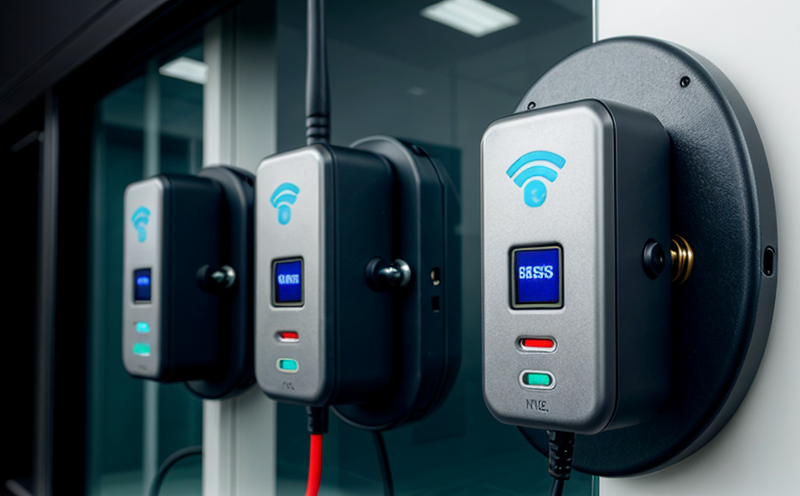IEC 62133 Battery Safety Testing for Wireless Communication Equipment
The International Electrotechnical Commission (IEC) standard IEC 62133 is a crucial document that outlines the safety requirements for batteries used in various electronic devices, including wireless communication equipment. This standard aims to ensure that batteries are safe and reliable, reducing the risk of fire, explosion, or other hazards associated with battery malfunctions.
Wireless communication equipment, such as smartphones, tablets, and portable routers, rely on rechargeable lithium-ion batteries for their operation. These devices often operate in environments where they can be exposed to extreme temperatures, mechanical stress, or other forms of abuse. Therefore, ensuring that the batteries meet stringent safety requirements is essential.
IEC 62133 defines a series of tests designed to evaluate the thermal, electrical, and mechanical stability of batteries used in wireless communication devices. These tests are critical for verifying that the battery will perform safely under various conditions, including overcharging, short circuits, impact, and vibration. The standard also covers the design and construction of the battery, ensuring it meets all safety criteria.
The testing process involves a series of simulated scenarios to assess the battery's behavior in different situations. For example, the thermal abuse test simulates high temperatures that might occur during normal use or storage conditions. Similarly, electrical abuse tests check how the battery reacts under extreme charging and discharging conditions. Mechanical abuse tests evaluate the battery’s resilience to physical stresses like drops, impacts, and vibrations.
At Eurolab, we provide comprehensive IEC 62133 testing services tailored to wireless communication equipment manufacturers and suppliers. Our state-of-the-art facilities use industry-standard test equipment to ensure accurate and reliable results. We follow the latest versions of the standard to guarantee our tests are up-to-date with current safety requirements.
The benefits of undergoing IEC 62133 testing include:
- Enhanced product safety, reducing the risk of battery-related incidents
- Compliance with international standards, ensuring market access in global markets
- Potential for improved brand reputation and consumer trust through proven safety measures
- Early identification of potential design flaws or manufacturing issues that could lead to safety hazards
- Access to valuable data on battery performance under various stress conditions, aiding product development
- Increased confidence in the quality and reliability of your wireless communication devices
- Support for regulatory compliance initiatives and ongoing product improvement programs
Our experienced team at Eurolab brings extensive expertise in IEC 62133 testing. We understand the nuances of wireless communication equipment design, allowing us to provide accurate and thorough testing. Our services are designed to help you meet stringent safety requirements while ensuring your products are fit for market.
Benefits
The implementation of IEC 62133 battery safety testing brings numerous advantages to wireless communication equipment manufacturers and suppliers:
- Enhanced Safety Profile: By adhering to this standard, you ensure that your products meet the highest safety standards, thereby protecting consumers from potential hazards.
- Compliance with International Standards: Compliance is crucial for market access and regulatory requirements. IEC 62133 helps manufacturers comply with global standards, facilitating easier entry into international markets.
- Consumer Trust: A proven safety record can significantly enhance consumer trust in your brand, leading to increased sales and customer loyalty.
- Product Quality Improvement: The testing process often reveals design or manufacturing issues that could be corrected early on, improving overall product quality.
- Regulatory Compliance: Ensuring compliance with IEC 62133 helps avoid legal issues and penalties associated with non-compliance.
- Economic Benefits: By identifying potential risks during the testing phase, manufacturers can save on costly recalls and product replacements post-launch.
At Eurolab, we pride ourselves on providing thorough and accurate testing that meets all IEC 62133 requirements. Our services are designed to help you achieve these benefits while maintaining high standards of quality and reliability in your wireless communication devices.
Eurolab Advantages
At Eurolab, we offer a range of advantages that make us the preferred choice for IEC 62133 battery safety testing:
- Expertise and Experience: Our team comprises highly skilled professionals with extensive experience in wireless communication equipment testing.
- State-of-the-Art Facilities: Equipped with the latest technology, our laboratories ensure accurate and reliable test results.
- Comprehensive Testing Services: We offer a full range of IEC 62133 compliance tests, including thermal, electrical, and mechanical abuse tests.
- Global Recognition: Our certifications are recognized worldwide, ensuring that your products meet international standards.
- Speedy Turnaround Times: We understand the importance of timely testing results. Our efficient processes allow for faster turnaround times without compromising on quality.
- Comprehensive Reporting: Our reports provide detailed insights into test performance, helping you make informed decisions about your product development and compliance strategies.
- Dedicated Support: Our dedicated team is always available to provide support and guidance throughout the testing process.
Partnering with Eurolab ensures that you receive top-notch services tailored to meet your specific needs, helping you stay ahead in a competitive market.
Competitive Advantage and Market Impact
In an increasingly interconnected world, wireless communication equipment plays a critical role. Ensuring the safety of these devices is not only a legal requirement but also a strategic business decision that can significantly impact your competitive position:
- Consumer Confidence: By demonstrating commitment to product safety, you build consumer confidence and trust.
- Market Access: Compliance with global standards like IEC 62133 opens doors to international markets, increasing your market reach.
- Regulatory Compliance: Avoiding non-compliance risks by adhering to this standard can save you from costly penalties and legal issues.
- Innovation: Testing ensures that new products meet the highest safety standards, encouraging innovation without compromising on quality.
- Better Brand Image: A strong safety record enhances your brand image and reputation, making it more attractive to potential customers.
EuroLab’s robust testing capabilities and comprehensive services provide a competitive edge by ensuring that your products are not only safe but also meet the highest international standards. This commitment to quality translates into better market positioning and increased customer satisfaction.





